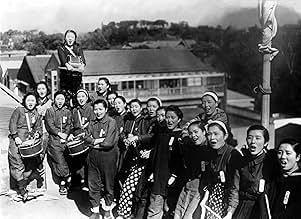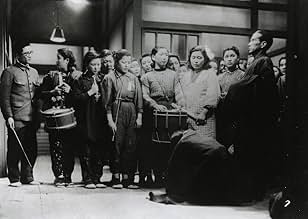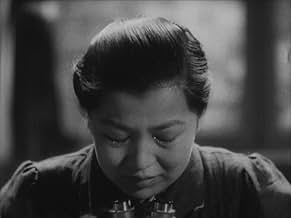NOTE IMDb
5,6/10
2,5 k
MA NOTE
Ajouter une intrigue dans votre langueWorld War II film about female volunteer workers at an optics plant who do their best to meet production targets.World War II film about female volunteer workers at an optics plant who do their best to meet production targets.World War II film about female volunteer workers at an optics plant who do their best to meet production targets.
Histoire
Le saviez-vous
- AnecdotesIn order to save film during wartime, the Japanese government ordered films to be released to have no opening titles and thus giving no credit to most of the actors or workers on each film. This included "The Most Beautiful" (1944).
- ConnexionsReferenced in Kurosawa: The Last Emperor (1999)
Commentaire à la une
Can outright propaganda lead to a great film experience? I think so. Mikhail Kalatozov's Soy Cuba was nothing but propaganda for the Cuban Revolution, and it's a remarkable watch. The problem in general, I think, is that the demands of propaganda and drama are almost always diametrically opposed. Drama requires certain stakes and potentialities that propaganda is naturally resistant towards. It also requires a certain level of subtlety that is anathema to propaganda. You don't need a subtly driven message of duty to one's country, you need to hit your audience over the head with duty to Imperial Japan against America and Britain. That lack of subtlety combined with the fact that there is no antagonist really derails any sort of audience investment in the actions of the characters in Akira Kurosawa's second film, a film specifically made for propaganda purposes, funded by the Japanese government in the middle of World War II.
The story is about a group of female workers in a factory that specializes in lenses for the military. We never see an American or Brit, instead we just follow the girls as they try to deal with life during a four months period where production must increase over quotas. Something felt off about this film from the beginning when Watanabe (Yoko Yaguchi) cries to management that it's unfair that the men's quota went up by 100% but the women's quota only went up by 50%. Surely management, led by the director of the plant (Takashi Shimura), doesn't think so little of the women and their commitment to the cause. Surely they can raise the women's quota to 67%. When Watanabe comes back and tells all the girls of her successful negotiation, they all break into cheers. Do I believe that Japanese women would feel great senses of duty to the Empire and the cause? Yes, I do. Do I believe that they would endeavor to work as hard as possible? Yes. The issue is that it's all too easy. There's never a dissenting voice in the group about the work they have to do or the pressures on them. Management is kindly patriarchal and never harsh. There's no real drama here. It's all just dedication to the cause.
The bulk of the movie tracks the girls' morale against the output with a very clear relationship between them being happy and them meeting their goals over the four months. The pieces that feel like drama are a girl, Suzumura (Asako Suzuki) getting slightly sick and her father coming from the country to Tokyo to take her home with the rest of the girls crying as she leaves with her begging their forgiveness for missing work. There's another girl, Koyama (Haruko Toyama) who constantly runs a slight fever at night, but Watanabe covers for her so that she can work while protecting her from other physical activity. When the woman who runs their dorm, Mizushima (Takako Irie), leaves for a few days to try and bring Suzumura back, the other girls turn on Watanabe, with her quietly accepting the verbal assault until Toyama tells everyone the truth about her low-grade fever and how it's all for the cause of helping them meet their quota. These bits of drama amount to little of interest because the characters are so uniform and everything is brought up and forgotten in minutes. All of these girls are completely interchangeable because they have no real character or desire other than to help increase output for the cause.
The ending of the film is dominated by a single event where Watanabe, in her job as an inspector of the lenses after production, misplaced a lens she hadn't fully inspected. If she doesn't find it and it goes out, there could be Japanese lives at risk, so she spends all night looking, eventually finding it with little more than a pat on the back by management. They're happy she worked so hard and not mad at all for her for the mistake. It's all very sanitized.
And that really points to a problem with propaganda like this. None of the girls can have any question about the cause or being overworked or have problems with management. Problems have to be with people who aren't dedicated to the cause (a father figure far removed from the factory) while it can't be anyone in the factory because that could imply there are saboteurs in actual factories. Without any real antagonists, problems have to come from misunderstandings between like-minded individuals. It's just not that interesting.
The most interesting thing about the film is two-fold. The first is the look at a real optics factory in Imperial Japan. It's almost a pseudo-documentary about the manufacture of lenses in a certain way. The second is Kurosawa's eye. There are times when the film is quite nice to look at. They're fewer and further between than in Sanshiro Sugata, but they are there. There's a shot of the girls gathered round a pair of barrels that's quite striking, and there's a small moment where one of the girls goes outside in the middle of the night into the vegetable garden they keep with the moon featured prominently in very nice ways.
Otherwise, the movie is kind of a drag. There's no real drama. The characters are thin and interchangeable. This was a burgeoning artist working under a tight artistic regime that demanded a storytelling mode that wasn't really amenable to compelling cinema.
The story is about a group of female workers in a factory that specializes in lenses for the military. We never see an American or Brit, instead we just follow the girls as they try to deal with life during a four months period where production must increase over quotas. Something felt off about this film from the beginning when Watanabe (Yoko Yaguchi) cries to management that it's unfair that the men's quota went up by 100% but the women's quota only went up by 50%. Surely management, led by the director of the plant (Takashi Shimura), doesn't think so little of the women and their commitment to the cause. Surely they can raise the women's quota to 67%. When Watanabe comes back and tells all the girls of her successful negotiation, they all break into cheers. Do I believe that Japanese women would feel great senses of duty to the Empire and the cause? Yes, I do. Do I believe that they would endeavor to work as hard as possible? Yes. The issue is that it's all too easy. There's never a dissenting voice in the group about the work they have to do or the pressures on them. Management is kindly patriarchal and never harsh. There's no real drama here. It's all just dedication to the cause.
The bulk of the movie tracks the girls' morale against the output with a very clear relationship between them being happy and them meeting their goals over the four months. The pieces that feel like drama are a girl, Suzumura (Asako Suzuki) getting slightly sick and her father coming from the country to Tokyo to take her home with the rest of the girls crying as she leaves with her begging their forgiveness for missing work. There's another girl, Koyama (Haruko Toyama) who constantly runs a slight fever at night, but Watanabe covers for her so that she can work while protecting her from other physical activity. When the woman who runs their dorm, Mizushima (Takako Irie), leaves for a few days to try and bring Suzumura back, the other girls turn on Watanabe, with her quietly accepting the verbal assault until Toyama tells everyone the truth about her low-grade fever and how it's all for the cause of helping them meet their quota. These bits of drama amount to little of interest because the characters are so uniform and everything is brought up and forgotten in minutes. All of these girls are completely interchangeable because they have no real character or desire other than to help increase output for the cause.
The ending of the film is dominated by a single event where Watanabe, in her job as an inspector of the lenses after production, misplaced a lens she hadn't fully inspected. If she doesn't find it and it goes out, there could be Japanese lives at risk, so she spends all night looking, eventually finding it with little more than a pat on the back by management. They're happy she worked so hard and not mad at all for her for the mistake. It's all very sanitized.
And that really points to a problem with propaganda like this. None of the girls can have any question about the cause or being overworked or have problems with management. Problems have to be with people who aren't dedicated to the cause (a father figure far removed from the factory) while it can't be anyone in the factory because that could imply there are saboteurs in actual factories. Without any real antagonists, problems have to come from misunderstandings between like-minded individuals. It's just not that interesting.
The most interesting thing about the film is two-fold. The first is the look at a real optics factory in Imperial Japan. It's almost a pseudo-documentary about the manufacture of lenses in a certain way. The second is Kurosawa's eye. There are times when the film is quite nice to look at. They're fewer and further between than in Sanshiro Sugata, but they are there. There's a shot of the girls gathered round a pair of barrels that's quite striking, and there's a small moment where one of the girls goes outside in the middle of the night into the vegetable garden they keep with the moon featured prominently in very nice ways.
Otherwise, the movie is kind of a drag. There's no real drama. The characters are thin and interchangeable. This was a burgeoning artist working under a tight artistic regime that demanded a storytelling mode that wasn't really amenable to compelling cinema.
- davidmvining
- 6 mars 2022
- Permalien
Meilleurs choix
Connectez-vous pour évaluer et suivre la liste de favoris afin de recevoir des recommandations personnalisées
- How long is The Most Beautiful?Alimenté par Alexa
Détails
- Durée1 heure 25 minutes
- Couleur
- Mixage
- Rapport de forme
- 1.37 : 1
Contribuer à cette page
Suggérer une modification ou ajouter du contenu manquant

Lacune principale
By what name was Le Plus dignement (1944) officially released in Canada in English?
Répondre
















